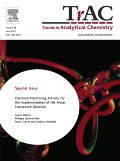
TRAC-TRENDS IN ANALYTICAL CHEMISTRY
Scope & Guideline
Pioneering Insights in Environmental and Spectroscopic Analysis
Introduction
Aims and Scopes
- Advanced Analytical Techniques:
The journal covers cutting-edge methodologies in analytical chemistry, including mass spectrometry, chromatography, and electrochemical sensing, facilitating the detection and quantification of various compounds in complex matrices. - Nanotechnology Applications:
A significant emphasis is placed on the utilization of nanomaterials and nanotechnology in sensor development, biosensing, and environmental monitoring, showcasing the role of nanoscale materials in enhancing sensitivity and selectivity. - Environmental and Food Safety Analysis:
The journal discusses analytical methods for detecting pollutants, contaminants, and emerging chemicals in environmental samples and food products, highlighting the importance of sustainability and safety in analytical practices. - Biochemical and Biomedical Applications:
Research focusing on biosensors and diagnostic tools for medical applications, particularly in disease detection and monitoring, is a core area, underscoring the intersection of analytical chemistry with health sciences. - Green Analytical Chemistry:
TRAC emphasizes sustainable practices in analytical methodologies, promoting the development and implementation of green solvents, eco-friendly extraction techniques, and overall greenness in analytical processes. - Artificial Intelligence in Analysis:
The incorporation of AI and machine learning techniques in data analysis and interpretation in analytical chemistry is a growing focus, facilitating advancements in precision and efficiency in research.
Trending and Emerging
- Microfluidics and Lab-on-a-Chip Technologies:
Research focusing on microfluidic devices and lab-on-a-chip technologies is on the rise, emphasizing their potential for rapid, portable, and efficient analysis in various applications, including diagnostics and environmental monitoring. - Biosensors and Point-of-Care Diagnostics:
There is a growing trend in developing advanced biosensors and point-of-care diagnostic tools, particularly for infectious diseases and chronic conditions, highlighting the demand for rapid and accurate testing methods. - Integration of AI and Data Analytics:
The application of artificial intelligence and advanced data analytics in analytical chemistry is increasingly prominent, facilitating improved data interpretation, predictive modeling, and automation in analytical processes. - Sustainability and Green Chemistry:
Emerging themes emphasize sustainable practices in analytical methodologies, with a focus on green solvents and environmentally friendly extraction techniques, aligning with global sustainability goals. - Nanomaterials in Sensing and Detection:
The use of nanomaterials for enhancing the performance of sensors and detection systems is rapidly gaining attention, showcasing their ability to improve sensitivity and specificity in various analytical applications. - Metabolomics and Exposomics:
Research in metabolomics and exposomics is expanding, driven by the need to understand complex biological systems and their interactions with environmental factors, facilitating advancements in health and environmental sciences.
Declining or Waning
- Traditional Chromatography Techniques:
There is a noticeable decline in papers focusing on conventional chromatography methods without innovative enhancements or applications, as researchers increasingly explore advanced and hybrid techniques. - Basic Analytical Methods without Integration:
Publications dedicated to fundamental analytical methods devoid of integration with modern technologies or interdisciplinary approaches are becoming less frequent, suggesting a shift toward more complex and integrated methodologies. - Focus on Inorganic Analysis:
Research centered solely on inorganic analysis is decreasing in favor of more comprehensive studies that incorporate organic and biochemical aspects, reflecting a broader scope of analytical chemistry. - Static Analytical Techniques:
Static or one-dimensional approaches to analytical chemistry are being overshadowed by dynamic and multi-dimensional techniques that provide more comprehensive insights into sample analysis.
Similar Journals
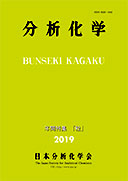
BUNSEKI KAGAKU
Empowering the Next Generation of ChemistsBUNSEKI KAGAKU, published by the Japan Society Analytical Chemistry, is a reputable journal dedicated to the field of analytical chemistry. With an ISSN of 0525-1931, this journal has been a crucial outlet for scholarly communication since its inception in 1952, converging its publication years from 1954 to 1957 and from 1959 to 2024. Although it holds a Q4 category ranking in the most recent 2023 quartiles of analytical chemistry and ranks 153/156 in Scopus, it continues to serve as a platform for quality research, fostering advancements in the field. BUNSEKI KAGAKU is based in Tokyo, Japan, and emphasizes the critical importance of analytical techniques in scientific inquiry. With a commitment to professionalism and rigor, the journal provides a vital resource for researchers, students, and professionals seeking to explore innovative methodologies and contribute to the ongoing dialogue in analytical chemistry.

Analytical and Bioanalytical Chemistry Research
Pioneering Insights in Bioanalytical Research.Analytical and Bioanalytical Chemistry Research is an esteemed open-access journal published by the Iranian Chemical Society, dedicated to the advancement of knowledge in the fields of analytical chemistry, biochemistry, and spectroscopy. Since its inception in 2014, this journal has provided a platform for researchers, professionals, and students to publish and access high-quality research articles that contribute to the understanding of chemical analysis and bioanalytical methods. With an ISSN of 2383-093X and an open-access model that promotes global dissemination of findings, it ensures that innovative research reaches a broad audience. The journal has consolidated its presence in the scientific community, currently ranked in quartile Q4 for analytical chemistry, biochemistry, and spectroscopy as of 2023. Its Scopus rankings, including a percentile of 34th in Analytical Chemistry, reflect its commitment to quality research and scholarly contribution. Situated in Tehran, Iran, the journal serves as a vital resource for academic discourse, offering insights into emerging trends and methodologies in analytical and bioanalytical chemistry.
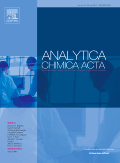
Analytica Chimica Acta
Advancing the frontiers of analytical chemistry.Analytica Chimica Acta is a prestigious peer-reviewed journal published by ELSEVIER, renowned for its significant contribution to the fields of analytical chemistry, biochemistry, environmental chemistry, and spectroscopy. Established in 1947, this journal has solidified its reputation, reflected in its impressive impact factors and Scopus rankings, including a Q1 classification in Analytical Chemistry and Spectroscopy, and a Q2 ranking in both Biochemistry and Environmental Chemistry. With its comprehensive scope, Analytica Chimica Acta aims to publish innovative research, critical reviews, and technical notes that advance the understanding and application of analytical methods. As an essential resource for researchers, professionals, and students alike, it encourages the dissemination of high-quality research that addresses contemporary challenges in chemical analysis and promotes interdisciplinary collaboration. While the journal operates primarily on a subscription basis, it also offers unique opportunities for authors to reach a broad audience and engage in the global scientific discourse.

MICROCHEMICAL JOURNAL
Advancing the Frontiers of Microchemical ResearchMicrochemical Journal, published by Elsevier, stands as a leading scholarly publication in the fields of Analytical Chemistry and Spectroscopy, boasting impressive rankings of Q1 and Q2 in their respective categories for 2023. With an H-index reflecting its substantial impact and relevance, this journal has been a cornerstone of research dissemination since its inception in 1957, and it continues to play a vital role in advancing the methodological and technological innovations within these disciplines. The journal presents peer-reviewed articles that explore a wide array of topics, making it an essential resource for researchers, professionals, and students keen on the latest advancements in microchemical processes and techniques. Although it does not currently offer open access options, its publication through Elsevier ensures a high standard of academic integrity and wide accessibility through various academic institutions. With a strong Scopus ranking—9th in Chemistry Spectroscopy and 22nd in Analytical Chemistry—Microchemical Journal is an indispensable platform for empirical studies, insightful reviews, and pioneering methodologies in the microchemical domain.

JOURNAL OF CHROMATOGRAPHY A
Shaping the Future of Chromatographic ScienceJOURNAL OF CHROMATOGRAPHY A, published by Elsevier, is a leading journal in the disciplines of Analytical Chemistry, Biochemistry, and Organic Chemistry, boasting an impressive 2023 Q2 categorization across multiple fields. With an ISSN of 0021-9673 and an E-ISSN of 1873-3778, this prestigious journal has been at the forefront of chromatography research since its inception in 1958. The journal serves as a vital platform for disseminating high-quality research articles, reviews, and insights into the latest developments in chromatographic techniques and applications, reflecting its standing in the top tier of analytical and organic chemistry literature, evidenced by its impressive Scopus rankings. While it currently operates under a subscription model, the journal continues to make significant contributions to the scientific community by fostering collaboration and innovation in chromatography methodologies. We invite researchers, professionals, and students to engage with the essential findings shared within its pages, which are foundational for advancements in various scientific fields, making it an indispensable resource for enhancing chromatographic knowledge and practice.
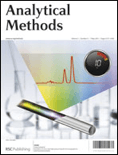
Analytical Methods
Advancing the Frontiers of Analytical ScienceAnalytical Methods, published by the renowned Royal Society of Chemistry, is a distinguished journal that has been serving the scientific community since its inception in 2009. Specializing in the fields of Analytical Chemistry, Chemical Engineering, and General Engineering, this journal holds a reputable position with an impressive Q2 ranking in three relevant categories as of 2023. With its focus on innovative methodologies and advanced applications in analytical science, it aims to disseminate cutting-edge research and foster dialogue among researchers, professionals, and students. Although it is not an open access publication, it is accessible worldwide and provides critical insights into the latest developments in analytical techniques and their engineering applications. The journal also ranks highly in pertinent Scopus categories, such as being in the 77th percentile for General Engineering and 61st percentile for Analytical Chemistry, underlining its significance in advancing knowledge and practical applications in these fields. By participating in this journal, readers can expect to engage with high-quality research that influences the future of analytical practices and chemical engineering.

Pakistan Journal of Analytical & Environmental Chemistry
Unveiling Insights into Analytical MethodologiesPakistan Journal of Analytical & Environmental Chemistry, published by the University of Sindh, National Centre of Excellence Analytical Chemistry, is a distinguished platform that has been committed to promoting high-quality research in the fields of analytical and environmental chemistry since its inception. With an ISSN of 1996-918X and an E-ISSN of 2221-5255, this journal has established itself as an open-access resource since 2007, facilitating the dissemination of knowledge to a global audience. Acknowledged for its contributions, the journal currently holds a Q4 category ranking in both Analytical Chemistry and Environmental Chemistry as of 2023, with Scopus rankings placing it within the challenging competitive bracket. The journal aims to publish original research, reviews, and technical notes that elucidate contemporary challenges and advancements, making it an essential read for researchers, professionals, and students who are exploring innovative methodologies and solutions in chemical analysis and environmental monitoring. By fostering a collaborative research environment and encouraging multidisciplinary approaches, the Pakistan Journal of Analytical & Environmental Chemistry plays a crucial role in advancing the field and addressing environmental concerns in Pakistan and beyond.

Separation Science Plus
Elevating the standards of separation science research.Separation Science Plus is an emerging academic journal dedicated to advancing the field of analytical chemistry and separation science. Published by WILEY-VCH Verlag GmbH, this journal provides a platform for researchers to disseminate high-quality studies and reviews that address innovative techniques and breakthroughs in separation methodologies. With its ISSN 2573-1815, the journal has made significant inroads since its inception in 2018, encompassing a convergence period until 2024. Despite currently holding a Q3 ranking in Analytical Chemistry and a Q4 ranking in Filtration and Separation, its dedication to publishing impactful research makes it a vital resource for professionals and students alike. The journal operates under the robust scholarly reputation of WILEY, which is known for its commitment to excellence in scientific communication. Researchers interested in the latest advancements in separation techniques will find Separation Science Plus an essential read, fostering the exchange of knowledge and facilitating greater understanding within this specialized field.
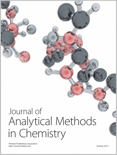
Journal of Analytical Methods in Chemistry
Unlocking insights through innovative methodologies.The Journal of Analytical Methods in Chemistry, published by HINDAWI LTD, stands as a premier platform dedicated to the dissemination of research in the vibrant field of analytical chemistry. With an ISSN of 2090-8865 and an E-ISSN of 2090-8873, this Open Access journal has been committed to providing unrestricted access to quality research since 1978, thereby fostering greater collaboration and innovation among researchers, professionals, and students globally. The journal showcases rigorous research insights spanning diverse categories, earning impressive Scopus rankings including Q2 in Chemical Engineering and Q3 in Analytical Chemistry for 2023, positioning itself effectively among respected peers. Its interdisciplinary approach also covers significant contributions in the realms of instrumentation and computer science applications, thus addressing contemporary challenges and advancements in analytical methodologies. By bridging theoretical underpinnings with practical applications, the Journal of Analytical Methods in Chemistry aims to catalyze knowledge exchange while enhancing the global discourse in analytical science.
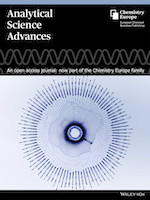
Analytical Science Advances
Advancing the Frontiers of Analytical ChemistryAnalytical Science Advances is a dynamic journal published by WILEY, dedicated to the ever-evolving field of analytical chemistry. With an ISSN of 2628-5452, this open-access platform aims to disseminate high-quality research and insightful reviews that push the boundaries of analytical methodologies and instrumentation. Since its inception in 2020, the journal has gained traction, securing a commendable Q2 ranking in 2023 within its category, highlighting its significance in the scientific community. Currently positioned at Rank #68 out of 156 in Scopus' analytical chemistry category, it boasts a 56th percentile ranking, reflecting its contributions to advancing analytical techniques. Researchers, professionals, and students will find this journal an invaluable resource for keeping abreast of the latest developments, emerging technologies, and innovative approaches in analytical science, ensuring the journal's relevancy and influence in shaping future discoveries.